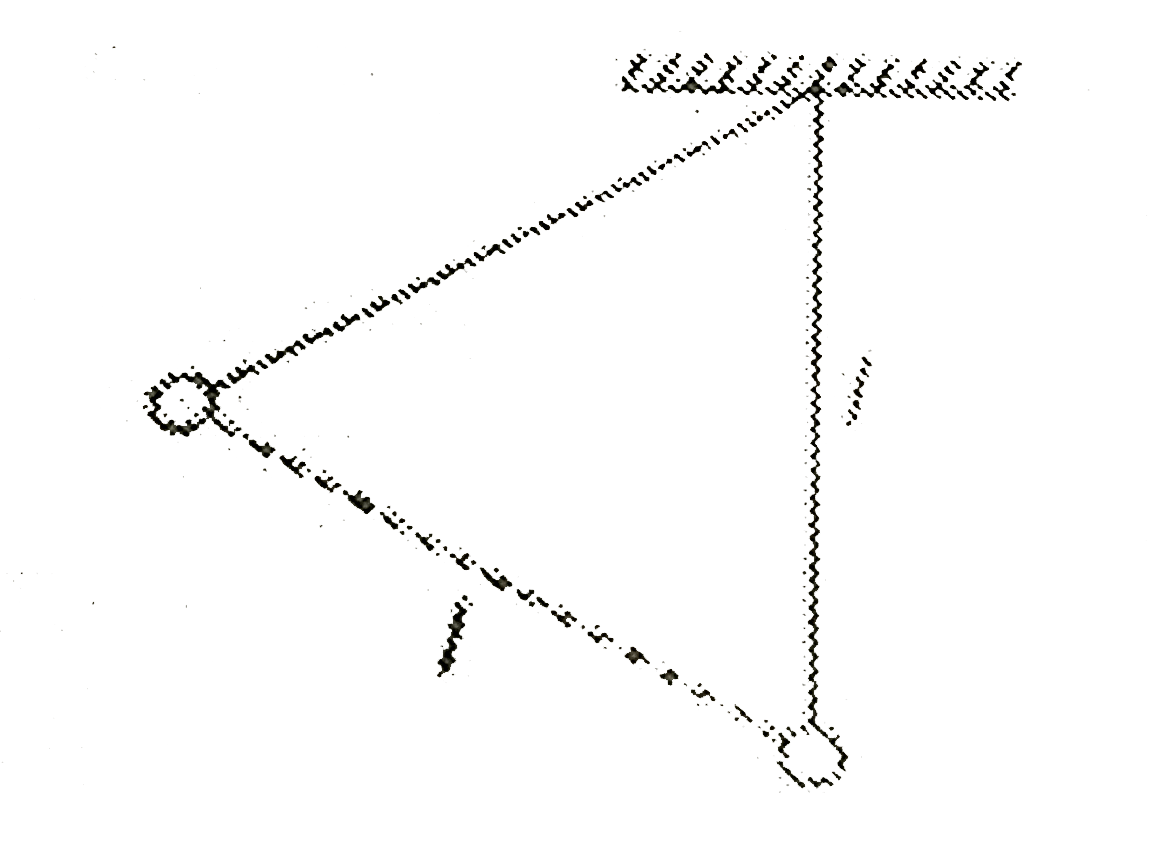A pendulum bob on a 2 m string is displaced 60∘ from the verticle and then released . What is the speed of the bob as it passes through the lowest point in its path?
√2m/s
√9.8m/s
4.43m/s
1/√2m/s
The correct Answer is:C
To find the speed of the pendulum bob as it passes through the lowest point in its path, we can use the principle of conservation of energy or the work-energy theorem. Here’s a step-by-step solution:
Step 1: Identify the given values
- Length of the string (L) = 2 m
- Angle of displacement (θ) = 60°
- Initial speed (u) = 0 m/s (since the bob is released from rest)
Step 2: Calculate the height (h) from which the bob is released
When the bob is displaced by an angle of 60°, the height (h) can be calculated using the formula:
h=L−Lcos(θ)
Substituting the values:
h=2−2cos(60°)
Since cos(60°)=12:
h=2−2⋅12=2−1=1 m
Step 3: Apply the work-energy theorem
According to the work-energy theorem:
Work done by gravity=ΔKE
The work done by gravity (W) is given by:
W=mgh
Where:
- m = mass of the bob (we will see it cancels out)
- g = acceleration due to gravity (approximately 9.8m/s2)
- h = height calculated above (1 m)
The change in kinetic energy (ΔKE) is:
ΔKE=KEfinal−KEinitial=12mv2−0=12mv2
Step 4: Set up the equation
Equating the work done by gravity to the change in kinetic energy:
mgh=12mv2
Step 5: Cancel mass (m) from both sides
Since mass m appears on both sides, we can cancel it out:
gh=12v2
Step 6: Rearrange to solve for speed (v)
Rearranging the equation gives:
v2=2gh
Taking the square root:
v=√2gh
Step 7: Substitute the values
Substituting g=9.8m/s2 and h=1m:
v=√2⋅9.8⋅1
v=√19.6
v≈4.427m/s
Conclusion
The speed of the bob as it passes through the lowest point in its path is approximately 4.427 m/s.
---
- Length of the string (L) = 2 m
- Angle of displacement (θ) = 60°
- Initial speed (u) = 0 m/s (since the bob is released from rest)
When the bob is displaced by an angle of 60°, the height (h) can be calculated using the formula:
h=L−Lcos(θ)
Substituting the values:
h=2−2cos(60°)
Since cos(60°)=12:
h=2−2⋅12=2−1=1 m
According to the work-energy theorem:
Work done by gravity=ΔKE
The work done by gravity (W) is given by:
W=mgh
Where:
- m = mass of the bob (we will see it cancels out)
- g = acceleration due to gravity (approximately 9.8m/s2)
- h = height calculated above (1 m)
ΔKE=KEfinal−KEinitial=12mv2−0=12mv2
Equating the work done by gravity to the change in kinetic energy:
mgh=12mv2
Since mass m appears on both sides, we can cancel it out:
gh=12v2
Rearranging the equation gives:
v2=2gh
Taking the square root:
v=√2gh
Substituting g=9.8m/s2 and h=1m:
v=√2⋅9.8⋅1
v=√19.6
v≈4.427m/s
The speed of the bob as it passes through the lowest point in its path is approximately 4.427 m/s.
Topper's Solved these Questions
Similar Questions
The mass of a pendulum bob is m = 2kg and the length of the string is l. It is displaced through 90∘ from the vertical and released. What minimum tension (in N) should the string should be able to withstand so that it doesn't break during motion?
View SolutionThe string of a pendulum is 2.0m long. The bob is pulled sideways so that the string becomes horizontal and then the bob is released. What is the speed with which the bob arrives at the lowest point ? Assume theat 10% of initial energy is dissipated against air resistance. Take g=10m/s2
View Solution
Knowledge Check
A pendulum bob on a 2 m string is displaced 60∘ from the vertical and then released. What is the speed of the bob as it passes through the lowest point in its path
A√2m/sB√9.8m/sC4.43m/sD1/√2m/sA simple pendulum of length 1m has bob of mass 100 g. It is displaced through an angle of 60∘ from the vertcal and then released. The kinetic energy of bob when it passes through the mean position is
A0.25JB0.5JC1.0JD1.4JA simple pendulum of bob mass m and length l is displaced from its mean position O to a point A and then released . If v is the velocity of the bob at O, h is the height of string of pendulum when bob passes through point O is /are (neglect friction )
A2mghlB2mg1+(h)lCmg1+(2h)lDmg1−(2h)l
The bob of pendulum of length l is pulled aside from its equilibrium position through an angle θ and then released. Find the speed v with which the bob passes through the equilibrium position.
View SolutionA pendulum bob of mass m and length L is released from angle θ with the vertical. Find
(a) the speed of the bob at the bottom of the swing and
(b) tension in the string at that time
View SolutionThe bob of a simple pendulum of length L, is displaced through 90∘, from its mean position and then released. What will be the tension in the string when the bob of mass m will be its lowest position ?
View SolutionThe bob of a simple pendulum of length L, is displaced through 90∘, from its mean position and then released. What will be the tension in the string when the bob of mass m will be at its lowest position?
View SolutionA bob hangs from a rigid support by an inextensible string of length l. If it is displaced through a distance l (from the lowest position) keeping the string straight and then released. The speed of the bob at the lowest position is

View Solution
